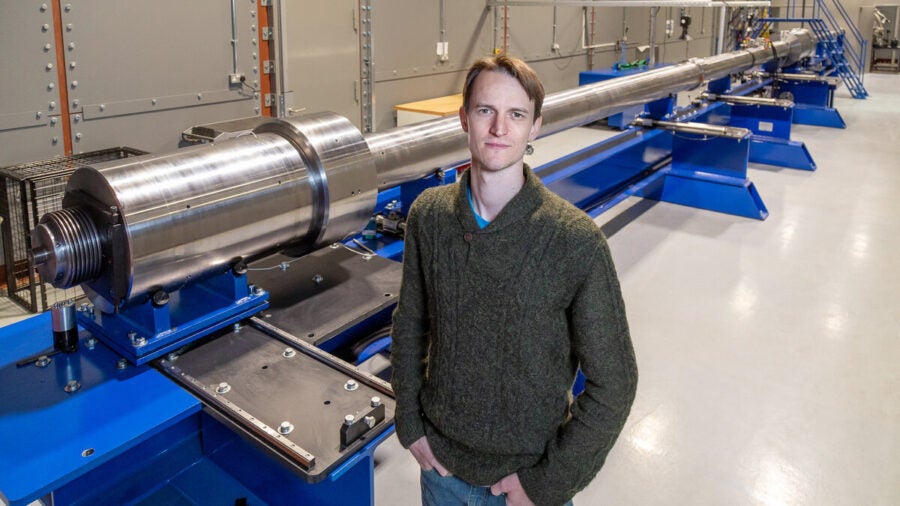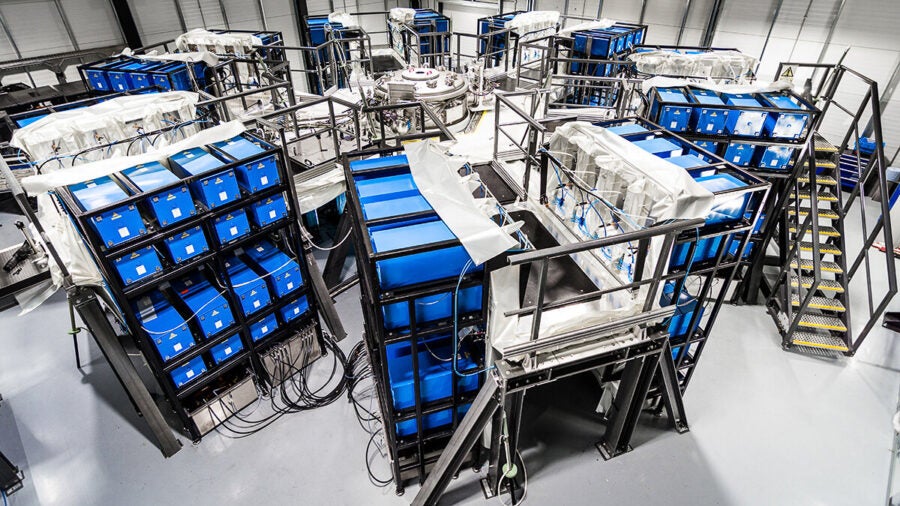
When Dr Nicholas Hawker was at the University of Oxford studying how pistol shrimps take down their prey, he was more interested in physics than biology. Could the little crustacean’s ability to produce a high-energy shockwave help him to create an affordable nuclear fusion power source that would enable the world to wean itself off fossil fuels?
“The shrimp has one outsized claw that it can snap really fast to make a shockwave strong enough to stun its prey. This also produces bubbles,” Hawker explains. “As the shockwave passes over the bubbles, it makes them collapse, which releases energy in the form of bright flashes of light. A big part of my PhD was studying that process of cavity collapse with fusion in mind. I wondered whether it could be applied to generate power. The answer was ‘probably not’, but it did help us to set up simulations to see how the principle could be adapted for use in fusion.”
Those simulations proved promising enough for him to co-found First Light Fusion in 2011 and, as its CEO and technology chief, attract more than £70m in funding for the business. At the end of 2021, the firm demonstrated that fusion was feasible, but its next big challenge is to achieve ‘gain’ – that is, create a reaction that produces more energy than it requires to get started. To this end, it has announced plans for a new demonstrator facility to be built at the UK Atomic Energy Authority’s research base at Culham, Oxfordshire.
Fission and fusion – two approaches to nuclear energy
Scientists pursuing nuclear fusion believe that it could play a vital role in meeting the world’s zero-carbon energy needs without creating significant amounts of radioactive waste.
It’s a bit like an internal combustion engine
Today’s nuclear reactors rely on fission, the process in which energy is created when atoms are fired at each other so that they split. In essence, fusion is the opposite approach. What First Light Fusion has done is fire a projectile into a target with such force that its atoms are crushed together. The target contains the separate fuel sources of hydrogen-2 and hydrogen-3, which collide to become helium-5 for a tiny fraction of a second at the start of the reaction. The helium-5 atom is unstable, so it naturally decays to helium-4, emitting a neutron from its nucleus. That process generates energy.
“It’s Einstein’s famous E = mc2 equation,” Hawker explains. “When helium-5 becomes helium-4 the mass is slightly reduced, so energy is released.”
To achieve this reaction on a large scale, researchers are broadly exploring two approaches. In one, a ball of plasma is heated to a temperature hotter than the Sun in a reactor called a tokamak. The plasma is held in suspension by huge superconductive magnets so that it doesn’t melt the sides of the reactor. The other approach, favoured by First Light Fusion, is known as inertial fusion.

Could fusion ever be affordable for all?
The finer details of First Light Fusion’s approach are a closely guarded secret. In essence, though, the process involves firing a projectile along a cylinder at several times the speed of sound and using an “amplifier” to increase the force of its impact on the hydrogen isotopes. This technology applies the science of cavitation (the formation and collapse of bubbles) – hence Hawker’s early interest in the pistol shrimp.
“The core process is not new; it’s the amplifier that’s unique to our approach,” he says. “The projectile hits the front of the amplifier, which focuses the energy of the projectile on to the fuel to create what’s needed for inertial fusion. We think our technology will make the existing process much simpler and generate clean energy at a lower cost.”
Cost is a key concern. Global investments in fusion research have run into billions of pounds already and the tech, if and when it becomes commercially viable, is likely to be hugely expensive to set up and run. In fact, the R&D costs are so colossal that nations are pooling their resources. For instance, the International Thermonuclear Experimental Reactor is a multinational collaboration – involving the US, China and Russia among several other stakeholders – to build and test a tokamak in the south of France. The project had an original budget of €6bn (£5.2bn) in 2012, but it’s expected to cost several times that amount before it can demonstrate ‘gain’ and be developed into a commercially viable power source.
The future for nuclear fusion
At Culham, a trial tokamak called the Joint European Torus set a world record at the end of 2022 by generating 11MW of energy in a five-second burst – enough to power 11,000 homes in that moment. Its ability to produce that much energy for that length of time was hailed as a major advance, but creating the reaction still required more energy than it generated. This is why the aim for scientists is to prove their approach not only works but can produce more energy than that needed to initiate and maintain the reaction.
Researchers at the Lawrence Livermore National Laboratory in California claim to have done exactly that. At the end of last year they announced that their technique, which uses lasers, had produced a fusion reaction generating 50% more energy than it consumed.
The US secretary of energy, Jennifer Granholm, has hailed it as “one of the most impressive scientific feats of the 21st century”. Hawker is similarly impressed, believing that it highlights the potential of the inertial approach.
First Light Fusion is aiming to emulate the Livermore team’s breakthrough with a demonstrator reactor called Machine 4, which is set to be the world’s largest pulsed power facility. Construction will start next year. If all goes to plan, the reactor could achieve gain before the end of the decade.
“Our pilot plant design will fire a projectile every 90 seconds,” Hawker says. “You use one target for one shot and it releases one big pulse of energy. Then you repeat the process. It’s a bit like an internal combustion engine, where the projectile serves as the spark plug – the part that puts in the energy that triggers the reaction. Each target should release about the same amount of energy as that produced by a barrel of oil.”
Hawker thinks that this approach is likely to be the most affordable way for any country to achieve fusion. If the process proves too costly, he fears that developing nations will be forced to keep burning fossil fuels – and that a golden opportunity to move the whole world on to clean renewable energy will be missed.

When Dr Nicholas Hawker was at the University of Oxford studying how pistol shrimps take down their prey, he was more interested in physics than biology. Could the little crustacean’s ability to produce a high-energy shockwave help him to create an affordable nuclear fusion power source that would enable the world to wean itself off fossil fuels?
“The shrimp has one outsized claw that it can snap really fast to make a shockwave strong enough to stun its prey. This also produces bubbles,” Hawker explains. “As the shockwave passes over the bubbles, it makes them collapse, which releases energy in the form of bright flashes of light. A big part of my PhD was studying that process of cavity collapse with fusion in mind. I wondered whether it could be applied to generate power. The answer was ‘probably not’, but it did help us to set up simulations to see how the principle could be adapted for use in fusion.”
Those simulations proved promising enough for him to co-found First Light Fusion in 2011 and, as its CEO and technology chief, attract more than £70m in funding for the business. At the end of 2021, the firm demonstrated that fusion was feasible, but its next big challenge is to achieve ‘gain’ – that is, create a reaction that produces more energy than it requires to get started. To this end, it has announced plans for a new demonstrator facility to be built at the UK Atomic Energy Authority’s research base at Culham, Oxfordshire.
